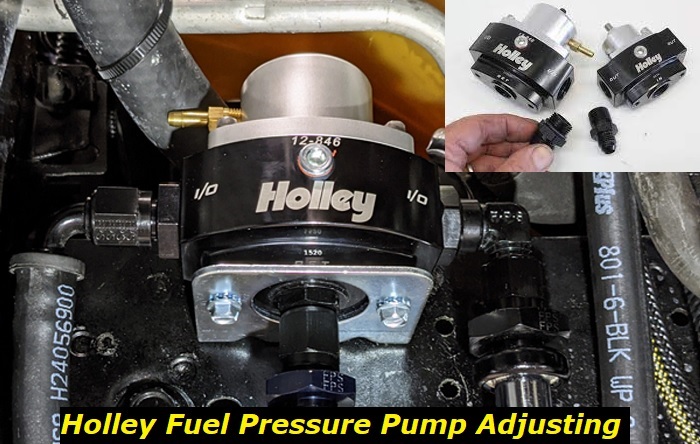Holley performance products are synonymous with quality and reliability. Holley is an American company that was established in the late 1800s. It is a company that has grown in leaps and folds to ensure that its customers get the best performance parts for their vehicles and machines.
Engine upgrades highlights
- Commonsystems:fuel supply, air supply, exhaust, software
- Average prices:$500 - $6,500
- Average waiting time:1 - 21 days
- Commonreasons:higher power and torque
- DIY mods:just minor things, usually plug & play
- Level of satisfaction:medium

Understanding the Holley fuel pressure regulator and how it works
A vehicle or a machine that uses an electric fuel pump requires a fuel pressure regulator. The fuel pressure regulator helps maintain the fuel pressure in an electronic fuel injection system. It is the regulator that determines the amount of fuel that goes into the engine. It is through this process that fuel gets to the fuel injectors.
The Holley fuel pressure regulator bleeds off a given amount of fuel from the injectors to control the fuel pressure. The manufacturer has designed the regulators in such a way that the fuel pressure control is precise between the fuel pump and the carburetor. It prevents too much pressure on a given needle and the seat assembly. Subsequently, this prevents the seat assembly and the needle from flooding and prevents drivability issues.
If in the event there is no fuel pressure regulator or malfunctions, the unregulated fuel gets into the injectors and blocks the pass-through to the tank. This will then make the pump force fuel to get to the injectors. This causes the injectors to fail, which means you will require an auto repair service to correct this issue.
Holley Company has designed regulators for both EFU and carbureted applications. You can go for the Holley black E-coated regulator or the polished chrome one. For the carbureted regulators, the pressure is pre-set at 6PSI while the EFI regulators are set at 60PSI. The manufacturer has designed the regulators to be adjustable, making it easy to adjust or regulate the fuel pressure.
The regulator is designed to ensure the pressure between the injector's inlet and outlet remains constant. The solenoid valves on the injectors make the valve open, overcoming the fuel pressure that keeps the valve closed. It, therefore, means that if the fuel pressure is too high, the solenoid will be unable to open the valve, which means the engine will have no fuel to burn.
Features of the Holley fuel pressure regulator
The Holley bypass regulators can either be chrome carbureted or black-coated. Here are the main features that make the Holley regulators stand out:
- Though the regulators come factory pre-set, the carbureted regulator can be adjusted from as low as 4.5 PSI up to 9 PSI.
- The manufacturer has included a mounting bracket to make the installation and adjustment of the regulator easy.
- The regulator is awarded a code 5 level in emission
- Al Holley fuel pressure regulators are adjustable. The regulators also come pre-set from the factory, which removes the need to worry about the regulator's suitability at the installation time.
- The regulator has been made using aluminum, and this helps at making the component sturdy and durable.
- The inlet measures 3/8" NPT and so does the outlet. This helps ensure that the pressure ratio between the intake and the outlet intakes remains constant.
How to adjust the Holley fuel pressure regulator correctly
As stated above, the Holley fuel pressure regulators come factory pre-set. However, this does not mean you can't adjust the regulator to suit your engine's needs. To readjust the pressure, all you need to do in a Holley regulator is loosen the lock nut at the top. By turning the lock nut clockwise, you are increasing the pressure. Turn the lock nut counterclockwise when you want to decrease the pressure.
While the Holley instruction manual showcases how the regulator should be adjusted, it is imperative that one uses a fuel pressure gauge. The gauge must be located between the carburetor and the fuel pressure regulator. If the fuel pump is a high-pressure one, then the regulator must be placed between the regulator and the pump.
If there are two carburetors, plug each into the available discharge ports. In the case where the carburetor is single, plug one of the ports and feed the carb from the other port. It is vital that you place the fuel pressure regulator as close as possible to the fuel rails or the carburetor. Do not mount the regulator on scorching surfaces such as exhaust manifolds to reduce the risk of fire and other dangers.
The Holley fuel pressure regulator can further be adjusted using the boost reference fitting. This extra feature has been included to complement some fuel systems that require it. To adjust the regulator using this fitting, you will be required to remove the vent plug. You should then replace it with a barb fitting and connect that fitting to the vacuum source of the engine.
When adjusting the Holley fuel pressure regulator or any other fuel pressure regulator, you must ensure all the fuel connections are leak-proof. The good thing with using a Holley fuel pressure regulator is that when you install or adjust it, it remains so until you readjust it. It does not slip because of the pressure it is subjected to; it remains as you have set it.
Possible consequences of adjusting the Holley fuel pressure regulator incorrectly
The installation and adjusting of the regulator should be conducted by a person who fully understands how fuel pressure systems and regulators work. The instruction manual that comes with the Holley fuel pressure regulator should be understood thoroughly before any attempt is made to install or adjust the regulator.
- In an instance where you turn the adjustment screw all the way, there will be excessive fuel pressure. When there is excessive fuel pressure, the fuel system will flood.
- There is a risk of a fire or even an explosion when the fuel system is flooded. This is why a fuel gauge must always be used when adjusting the pressure regulator.
- The fuel bowl float level will change when the fuel pressure regulator is adjusted. This then means that whenever a regulator is adjusted, the fuel bowl should also be readjusted to ensure that the fuel system performs optimally.
Symptoms of damage to the fuel pressure regulator
You should be aware of the symptoms to look out for to confirm that your fuel pressure regulator is malfunctioning. It is crucial that you know that a faulty fuel pressure regulator can cause all manner of problems, from engine underperforming to the risk of fires and explosions. Here are the symptoms of a defective regulator;
- Decreased engine power and misfiring - If the regulator has any issues, the fuel pressure to the engine will be interrupted. The air-to-fuel ratio will be interrupted, and this can result in the engine performance being affected adversely.
- Fuel leakages - This issue arises mainly when the regulator diaphragm or seals are faulty. Fuel leaks are dangerous and will also result in the car underperforming.
- Black exhaust smoke - Black smoke from the car's exhaust is the other symptom that can help you diagnose a fuel pressure regulator fault. The engine can also run rich, and this would mean the fuel efficiency will significantly reduce.
- A noisy fuel pump - A faulty regulator will usually be accompanied by a whirring noise which can be pretty irritating. This noise is best picked when you are stuck in traffic. However, you should be aware that the fuel pump usually makes a humming sound, but when the regulator is faulty, the sound is loud and whirring.
- Engine issues - You might notice fuel coming out through the tailpipe. You may also see fuel in the vacuum pipe. This means that the fuel system is flooded, and the engine cannot burn all fuel hence some coming out from the tailpipe.
The conclusion
Holley fuel pressure regulators are trusted not because they bear a beautiful badge but because the manufacturer has been supplying the market with high-quality and reliable fuel performance components. The regulator from Holley is one of the best in the market.
Adjusting the Holley fuel pressure regulator is easy. However, it is advisable that a qualified person do the adjusting. Though it sounds easy to adjust the regulator, you must bear in mind that there are dangers associated with incorrect adjustment. It is, therefore, imperative that you have a good understanding of how the fuel system works as well as the risks associated.
In conclusion, to best understand how and why you need to adjust the fuel pressure regulator, you should appreciate how a malfunctioning regulator behaves. This way, you will have an easy time diagnosing whether the regulator is the one that requires adjusting.
About the authors
The CarAraC research team is composed of seasoned auto mechanics and automotive industry professionals, including individuals with advanced degrees and certifications in their field. Our team members boast prestigious credentials, reflecting their extensive knowledge and skills. These qualifications include: IMI: Institute of the Motor Industry, ASE-Certified Master Automobile Technicians; Coventry University, Graduate of MA in Automotive Journalism; Politecnico di Torino, Italy, MS Automotive Engineering; Ss. Cyril and Methodius University in Skopje, Mechanical University in Skopje; TOC Automotive College; DHA Suffa University, Department of Mechanical Engineering





Add comment